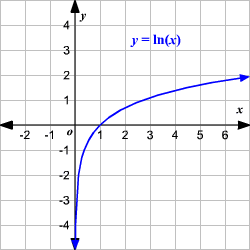
How do you find the domain and range of a natural log?
Answer
545.7k+ views
Hint: Logarithmic functions are the inverse of exponential functions. Therefore, the input argument to this function (the domain of the function) is equal to the logarithmic base power of a number. For natural log, the base is $e$ ,where $e$ is the Euler’s number. $\left( {e \approx 2.72} \right)$.
Formula used:
$\ln x = y$
$ \Rightarrow {\log _e}x = y$
$ \Rightarrow x = {e^y}$
Complete step-by-step solution:
We have $\ln x = y$ or $x = {e^y}$.
Since $e$ is a positive number, ${e^y}$ should be a positive number as well for any values of $y$.
That is, $x > 0$
Therefore, the domain of the natural log is:
$0 < x < \infty $
Or $x \in \left( {0,\infty } \right)$ .
Now,
$\mathop {\lim }\limits_{x \to 0} \ln x = - \infty $ and $\mathop {\lim }\limits_{x \to \infty } \ln x = \infty $ --------(1)
Given, $y = \ln x$
$ \Rightarrow \dfrac{{dy}}{{dx}} = \dfrac{1}{x} > 0$ for all $x \in \left( {0,\infty } \right)$
Therefore, we can say that the natural log function is a monotonically increasing function. Thus, from equation (1), we can say that the range of the natural log function is:
$ - \infty < y < \infty $
Or $y \in \left( { - \infty ,\infty } \right)$.
Thus, the domain of the natural log function is $\left( {0,\infty } \right)$ while its range is $\left( { - \infty ,\infty } \right)$ .
Additional information:
The graph of natural log function has a vertical asymptote as $x \to 0$ but does not have a horizontal asymptote.

For logarithmic function to any base, as \[x = 0,\ln x = 1\] .
Also, all logarithms have the property of mapping multiplication into addition as:
$\ln xy = \ln x + \ln y$
Note: Natural log functions are found very useful in integration problems involving certain types of integrands. Much of the power of logarithms is their usefulness in solving exponential equations
Formula used:
$\ln x = y$
$ \Rightarrow {\log _e}x = y$
$ \Rightarrow x = {e^y}$
Complete step-by-step solution:
We have $\ln x = y$ or $x = {e^y}$.
Since $e$ is a positive number, ${e^y}$ should be a positive number as well for any values of $y$.
That is, $x > 0$
Therefore, the domain of the natural log is:
$0 < x < \infty $
Or $x \in \left( {0,\infty } \right)$ .
Now,
$\mathop {\lim }\limits_{x \to 0} \ln x = - \infty $ and $\mathop {\lim }\limits_{x \to \infty } \ln x = \infty $ --------(1)
Given, $y = \ln x$
$ \Rightarrow \dfrac{{dy}}{{dx}} = \dfrac{1}{x} > 0$ for all $x \in \left( {0,\infty } \right)$
Therefore, we can say that the natural log function is a monotonically increasing function. Thus, from equation (1), we can say that the range of the natural log function is:
$ - \infty < y < \infty $
Or $y \in \left( { - \infty ,\infty } \right)$.
Thus, the domain of the natural log function is $\left( {0,\infty } \right)$ while its range is $\left( { - \infty ,\infty } \right)$ .
Additional information:
The graph of natural log function has a vertical asymptote as $x \to 0$ but does not have a horizontal asymptote.

For logarithmic function to any base, as \[x = 0,\ln x = 1\] .
Also, all logarithms have the property of mapping multiplication into addition as:
$\ln xy = \ln x + \ln y$
Note: Natural log functions are found very useful in integration problems involving certain types of integrands. Much of the power of logarithms is their usefulness in solving exponential equations
Recently Updated Pages
Master Class 9 Social Science: Engaging Questions & Answers for Success

Master Class 9 Science: Engaging Questions & Answers for Success

Master Class 9 English: Engaging Questions & Answers for Success

Master Class 9 Maths: Engaging Questions & Answers for Success

Master Class 11 Economics: Engaging Questions & Answers for Success

Master Class 11 English: Engaging Questions & Answers for Success

Trending doubts
Which places in India experience sunrise first and class 9 social science CBSE

Fill the blanks with the suitable prepositions 1 The class 9 english CBSE

Write the 6 fundamental rights of India and explain in detail

Difference Between Plant Cell and Animal Cell

What is the Full Form of ISI and RAW

Golden Revolution is related to AFood production BOil class 9 social science CBSE




